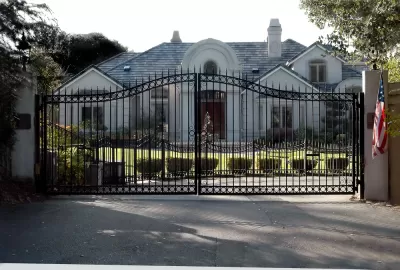"And you know why they made the new twenties? Cause I got all the old ones."

Inequity in the United States continues to grow, and that inequity is increasingly generational. Older Americans own the lion's share of homes and properties, and as the value of these properties increases, so does the wealth gap.
Politicians talk a fair amount about income inequality, but wealth inequality, which includes not just wages but also the value of properties and investments, paints a starker picture of further inequality. Over the past few decades that inequity has become increasingly a difference between the old and young. "Since 1989, all of the net increase in wealth has been experienced by households now aged 65 and older. The wealth of those aged 55 to 64 is essentially the same is in 1989 (up just 3 percent); those under 55 are decidedly poorer; the average wealth of those 35 to 44 is 43 percent less than in 1989, and for those 45 to 54, is 33 percent less than in 1989," Joe Cortright writes for CityObservatory.
A lot of this disparity is driven by the value of homes, because a home is the largest asset that many households have. As the value of homes went up, it drove wealth to homeowners who had owned their properties for long enough to benefit from that increase. "In short, younger adults have seen their housing equity shrink precipitously, while older Americans have experienced a rapid increase in their housing equity," Cortright reports.
FULL STORY: Gerontopoly: Homeownership, wealth, and age

Alabama: Trump Terminates Settlements for Black Communities Harmed By Raw Sewage
Trump deemed the landmark civil rights agreement “illegal DEI and environmental justice policy.”

Study: Maui’s Plan to Convert Vacation Rentals to Long-Term Housing Could Cause Nearly $1 Billion Economic Loss
The plan would reduce visitor accommodation by 25% resulting in 1,900 jobs lost.

Why Should We Subsidize Public Transportation?
Many public transit agencies face financial stress due to rising costs, declining fare revenue, and declining subsidies. Transit advocates must provide a strong business case for increasing public transit funding.

Paris Bike Boom Leads to Steep Drop in Air Pollution
The French city’s air quality has improved dramatically in the past 20 years, coinciding with a growth in cycling.

Why Housing Costs More to Build in California Than in Texas
Hard costs like labor and materials combined with ‘soft’ costs such as permitting make building in the San Francisco Bay Area almost three times as costly as in Texas cities.

San Diego County Sees a Rise in Urban Coyotes
San Diego County experiences a rise in urban coyotes, as sightings become prevalent throughout its urban neighbourhoods and surrounding areas.
Urban Design for Planners 1: Software Tools
This six-course series explores essential urban design concepts using open source software and equips planners with the tools they need to participate fully in the urban design process.
Planning for Universal Design
Learn the tools for implementing Universal Design in planning regulations.
Smith Gee Studio
Alamo Area Metropolitan Planning Organization
City of Santa Clarita
Institute for Housing and Urban Development Studies (IHS)
City of Grandview
Harvard GSD Executive Education
Toledo-Lucas County Plan Commissions
Salt Lake City
NYU Wagner Graduate School of Public Service





























